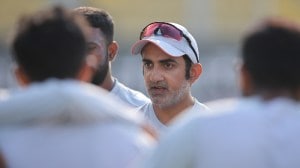Stay updated with the latest - Click here to follow us on Instagram
Dapoli villagers told to keep an eye out as whale may wash up again
Programme associates of the GIZ project along with a local NGO called Sahyadri Nisarg Mitra and forest guards were involved in the rescue.
 The whale was stranded in 4-feet shallow water at Dapoli in Ratnagiri district
The whale was stranded in 4-feet shallow water at Dapoli in Ratnagiri district
Three days after a 40-foot whale was rescued from the coast of Kolthare village at Dapoli in Ratnagiri district, villages along the coast have been alerted to keep an eye out for the mammal that can wash ashore again. The whale was stranded in 4-feet shallow water on February 1 and had been successfully released into the sea after a nine-hour rescue effort. Those who were part of the rescue said the whale had a stomach infection, which could have caused its disorientation, bringing it so close to the shore.
“There is not much first-hand experience about what may happen to the whale once it is released into the sea after being stranded. So, we have alerted people who live on the coast, the local fisheries department staff and others, including fishermen, to inform us if the mammal is spotted again,” said Bhaskar Paul, programme officer with the GIZ-funded Coastal and Marine Protected Area project, implemented by the Mangrove Cell, Mumbai.
Programme associates of the GIZ project along with a local NGO called Sahyadri Nisarg Mitra and forest guards were involved in the rescue.
Read | Maharashtra: 40-foot-long blue whale rescued off Dapoli coast
On February 1, a volunteer assigned with tracking the nesting of turtles on the beach, had spotted the whale struggling in shallow water on the coast. He alerted the forest department and the programme officers of the GIZ project. The whale was stuck in sand and the group first made an effort to keep it moist. The team also summoned a veterinary doctor to the site who examined the whale and diagnosed that it might have been suffering from a stomach infection.
“The whale had no injuries but it may have been in pain since it was stuck in shallow water and could not even attempt to swim back. It was given antibiotics and injections before we began making attempts to rescue it,”said Abhinay Kelaskar, the programme officer of the GIZ project in Ratnagiri who was present during the rescue.
Along with help from locals in Dapoli, the first attempt was to push the whale into the sea which proved unsuccessful. “We then called for two trawler boats and ropes were tugged gently on the whale’s sides. With the help of the boats, the whale was taken into the sea and released,” Kelaskar said.
Last year, the first live beaching case of a blue whale had occurred in Alibaug. Despite the rescue effort, that whale could not be saved. Last week, a 37-feet dead bryde’s whale had washed ashore which was buried without an autopsy. Having learnt lessons from these, the mangrove cell had come up with a protocol on specific roles of various departments in a situation like this. N Vasudevan, chief conservator of forests of the mangrove cell said that this was the first successful rescue operation of a whale in the state.







